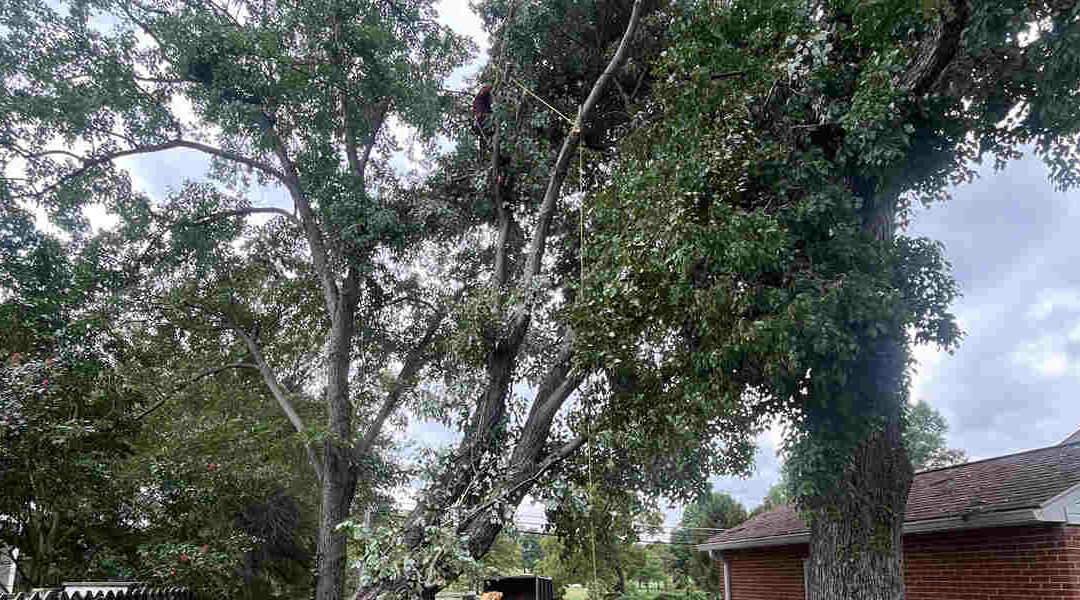Tree cabling is an effective method of maintaining the health and stability of your trees — especially young trees and those with structural weaknesses.
The process involves installing cables between branches to provide additional structural support, minimizing risks of splitting or breaking, and protecting a tree’s long-term viability.
Read on below for some details about tree cabling from Dos Amigos Tree Experts, the premier tree service in Falls Church, VA.
What Is Tree Cabling?
Tree cabling is a preservation technique developed by professional arborists that reinforces trees that are at risk of structural damage or failure. Properly placed cables with appropriate tension promote tree stability and limit unnecessary movement of weak branches.
Arborists often recommend cabling for trees with co-dominant stems, weak crotches, or overextended limbs. These conditions threaten undue stress on a tree’s supporting structures.
Trees located near buildings, utility lines, driveways, or roads present enhanced risks related to structural failure. They are often prime candidates for cabling to mitigate the risk of catastrophic damage or personal injury.
Arborists also often recommend cabling for trees that have already sustained damage. As a strategy for tree preservation, cabling can reinforce weak points and guide growth in a proper direction.
The two primary types of tree cabling systems are static systems using steel cables and dynamic systems using rope.
The steel cables used in static systems provide rigid support. In contrast, dynamic systems are more flexible, allowing for natural but reduced movement.
Both types of cabling systems serve the same purpose — to promote healthy growth while reducing the chance of storm damage and other hazards that can cause structural failure.
How To Cable a Tree: Best Practices
These are the steps that professional arborists typically follow when executing tree cabling.
Safety First
Working with trees is inherently dangerous. Wear proper safety gear, including gloves, helmets, and safety glasses. For large or complex trees, professionals follow a strict safety protocol.
Assess the Tree
Identify weak or damaged limbs that need reinforcement. Focus on branches that present enhanced risks to property or safety.
Select Cabling Points
Experts usually select two sturdy limbs with wide crotch angles as anchor points. Those limbs must be able to support the cabled branches’ entire weight adequately.
Install the Cables
Arborists measure the distance between anchor points and install properly sized cables or ropes. Then a professional uses appropriate hardware to secure the cables correctly.
Tighten Gradually
Arborists gradually tighten cables to the proper tension. The slow and measured process ensures safety and protects the tree from damage.
Inspect Regularly
Regular inspections of tree cabling systems are essential. As time passes, cables can loosen, and hardware can degrade or fail. Periodic maintenance is necessary to ensure tree stability and successful cabling.
The Benefits of Tree Cabling
Professional tree cabling provides a number of benefits, including:
- Storm damage prevention. Cabling reduces the risk of breakage during high winds and storms.
- Limb reinforcement. Cabling redistributes stress — enhancing the tree’s overall stability.
- Tree maintenance. Along with regular inspections, adjustments, and pruning, cabling promotes long-term tree health and stability.
- Preservation and safety. Cabling preserves trees that might otherwise require removal while making property safer.
Call Dos Amigos Tree Experts for Help With Tree Preservation
Dos Amigos Tree Experts is passionate about helping trees thrive and enhance our local environment and your property. We deliver high-quality tree maintenance services, including tree cabling and limb reinforcement, to help your trees thrive. We take a great interest in helping every customer learn more about how to take care of trees.
Call us today at (703) 300-6103 for a free estimate and to schedule service. We’re ready to help.


